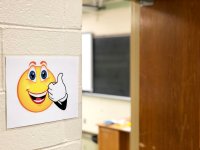Easy, Informal Professional Development
Opening your classroom so your fellow teachers can just drop by and observe is a low-pressure way to collaborate and share best practices.
On Grey’s Anatomy—yes, I still watch it—my favorite scenes are the ones in the operating theater. They’re a simple example of something that is also our greatest tool as teachers: modeling. As an educator, I’m used to modeling when teaching my students. Yet other than compulsory observation required in teacher-training programs, many educators rarely see any classroom besides their own.
In our school, Northern Valley Regional High School in New Jersey, our local professional development committee created our own version of the operating theater (without spilling any blood). We called it our “Open Classrooms” initiative.
The genesis was simple enough: Many of us wanted the benefit of another set of eyes, or to share a new tool or technique with colleagues. We also knew that even the best explanation lacked the power of a real-time demonstration with students. So teachers invited others into their classrooms and received honest, non-evaluative feedback, as well as validation and support from their colleagues.
What we did not expect, though, was how much visiting others would energize us. Even more unexpected? We were learning not just from our colleagues but also from their students.
The First Year of Open Classrooms
We liked that other schools that had created similar practices used signs and charts to indicate which classrooms were open to visitors. We chose a clipart picture of a smiley face with a thumbs-up gesture, hoping that others would see the sign and join in. Our goal was for the Open Classrooms concept to catch on naturally, with people inviting and visiting because they wanted to. A number of teachers opened their classrooms on a daily basis.
When we began, we were successful in many ways that we could not have planned. Some of our committee members had the thoughtful idea to bring newer teachers along on visits. Doing so enabled the new teachers to see veterans in their classrooms. Traveling alongside established teachers also demonstrated that regardless of how long you’ve taught, there are still new tricks worth learning.
We set clear norms for visits. We agreed that they could be short, even just a few minutes, because we wanted to encourage a casual atmosphere where people felt comfortable dropping by a class. It was also OK to take your sign down if you were not open to visitors. The informality led to a more authentic professional development experience. Teachers could visit an Open Classroom and then go back to planning or grading.
Finally, we made an effort to discuss the status of our Open Classrooms at each monthly professional development committee meeting so that we could share the wonderful things we were seeing.
Though our first year went well, visits tapered off as the school year concluded, and the long summer break made it difficult to start again in the fall. We wanted to get the momentum going again while maintaining the organic, grassroots feel. So we developed Open Classroom Wednesday as an add-on to our usual daily practice. This monthly celebration encouraged staff to visit their colleagues’ classrooms, as well as to open their own.
Planning an Open Classroom Wednesday
You can’t just call an upcoming Wednesday “Open Classroom Wednesday” and hope everythig works out. The following steps were hugely beneficial to us.
- Our committee designated cheerleaders, whose job was to hang out in the faculty room at the start of each period and rally participants for classroom visits.
- Using Google Sheets, we shared a list of each period’s open classrooms with committee members and cheerleaders so they could easily go to the classrooms where teachers were expecting visitors.
- We advertised our Open Classroom Wednesday in staff-wide emails and using our district hashtag on Twitter.
- We reminded all participants, new and returning, of our Open Classroom norms—that visits should be non-evaluative and short. The point was to see the positive things happening in our colleagues’ classrooms and to interact with students in environments other than our own classrooms.
Takeaways
Our first Open Classroom Wednesday was a great success. Nineteen teachers visited 24 different classrooms that day. Many teachers were first-time participants and took away with them their own smiley face signs.
Students seemed intrigued by our initiative as well. When one of our teachers told her students that we were learning from one another, one of them responded, “That’s so cool!” A student told another teacher, “I wish we could do that.” This highlighted for us that by participating in Open Classrooms, we were modeling responsible and reflective learning behaviors for our students. And because we were asking students about their lessons, we had an inside view of what authentic learning looks like in different contexts, and we were learning from them, as well.
